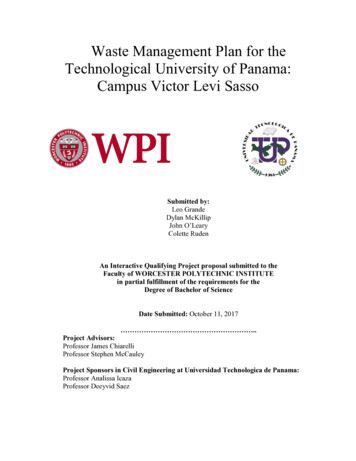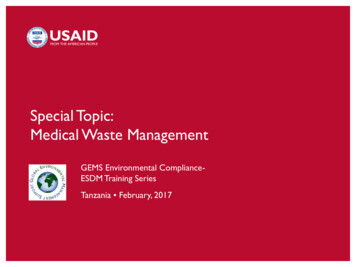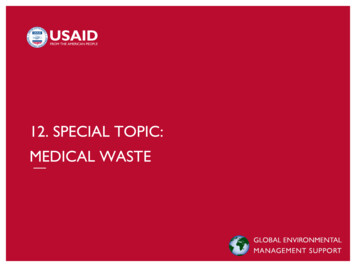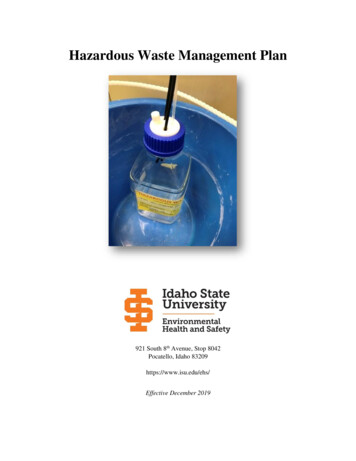
Transcription
Revision HistoryMedical Waste Management PlanVersion: 3.2Approved by: Philip BarruelNext Review:As NeededBiosafety Officer:Philip BarruelApproval Date: 7/22/2020Author:James Baugh, Ph.D.,RBP, CBSPApproval Date: 7/22/2020VersionDate ApprovedAuthorRevision Notes:1.011/4/16James BaughDocument created.2.05/22/17James BaughDocument revised per CDPH request.3.05/3/18James BaughDocument revised per CDPH request.3.15/24/18James BaughDocument revised.3.27/22/2020James BaughDocument revised, only changed documentreview date to “As Needed”
TABLE OF CONTENTSI. Introduction . 1A. Purpose . 1B. Applicability. 1C. Roles and Responsibilities . 1D. Reference. 2II. Waste Identification . 3A. Biohazard Waste . 3B. Sharps Waste . 4C. Pathology Waste . 4D. Pharmaceutical Waste . 4E. Trace Chemotherapeutic Waste . 4F. Mixed Waste. 5III. Waste Management. 5A. Solid Autoclave Waste . 5B. Sharps Biohazard Waste. 6C. Non-Biohazard Material Sharps . 7D. Solid Incineration Waste . 7E. Pharmaceutical Waste . 8F. Liquid Mixed Waste . 8IV. Waste Maintenance . 9A. Accumulation Site. 9B. Exceptions . 9C. Documentation . 10D. Emergency Action Plan . 10E. Medical Waste Treatment Facilities . 10V. Waste Supplies and Equipment . 11A. Collection Bag . 11B. Sharps Container . 11C. Biohazard Waste Secondary Container . 11D. Pharmaceutical Waste Container . 11E. Contracted Vendor . 12F. Terminal Autoclaves. 12VI. Waste Training . 12A. Safety Training . 12B. Certification . 13
MEDICAL WASTE MANAGEMENT PLANI. IntroductionA. PurposeThe purpose of this plan is to specify the procedures used to handle and dispose of medical wasteat the University of California, Davis (UC Davis). UC Davis conducts a wide range of agricultural,biomedical, veterinary, and basic scientific research, and is home to veterinary clinics. UC Davisis a large-quantity generator that produces approximately 200,000 pounds of autoclavable solidbiohazard waste, and 75,000 pounds of pathology waste, trace chemotherapeutic waste, andpharmaceutical incineration waste per year. The California National Primate Research Center(CNPRC) on the UC Davis campus treats approximately 40,000 pounds of biohazardous medicalwaste onsite annually, in California Department of Public Health (CDPH) permitted autoclaves.Throughout campus, liquid medical waste is treated with an agent-appropriate disinfectant foran appropriate amount of time, and then either drain-disposed or directed into the appropriatehazardous waste stream. Medical waste is transferred to one of the accumulation sites where thetransport/treatment vendor, Stericycle, picks up the medical waste.B. ApplicabilityThe Medical Waste Management Plan applies to ALL departments, laboratories, and personnelconducting research that results in the generation and disposal of medical waste materials.Medical waste materials include biohazard waste, sharps waste, pathology waste, tracechemotherapeutic waste, pharmaceutical waste, and mixed waste.C. Roles and ResponsibilitiesThe Biological Safety Officer oversees the Medical Waste Management Plan. The BiosafetyOfficers are trained on the contents of this plan, and are able to train and assist the UC Daviscommunity to safely and correctly dispose of biohazardous waste.Principal Investigators (PIs) and their research group are responsible for: Maintaining current approvals from any institutional regulatory committees i.e., theInstitutional Review Board (IRB), the Institutional Biosafety Committee (IBC), the1UC Davis Medical Waste Management Planv3.2
Institutional Animal Care and Use Committee (IACUC), the Stem Cell Research Oversightcommittee (SCRO), etc. that are required for operations and practices at the facility. Complying with the Medical Waste Management Act: California Health and Safety Code,Division 104, Part 14: Medical Waste, Sections 117600 – 118360, the California Code ofRegulations, Title 8, Section 5193: Bloodborne Pathogen Standard, and all other federal,state, and institutional requirements involving biohazardous waste disposal. Adhering to all the procedures in this Medical Waste Management Plan. Ensuring all personnel complete and maintain the required safety training prior to handling,generating, or transporting medical waste, in addition to laboratory-specific training. Immediately reporting exposure or spills involving biohazardous materials, includingbiohazard waste.All personnel generating medical waste are responsible for reading and complying with therequirements set out in this plan.Each medical waste accumulation site has a representative who is responsible for maintenance ofthe biohazard accumulation waste storage site, and facilitates the pick-up of medical waste withStericycle. Personnel responsible for accumulations sites, or other assigned personnel willcomplete the UC Davis Medical Waste Management Training. Upon completion, all of theseindividuals will help manage and maintain the storage site to ensure regulatory compliance.Online Bloodborne Pathogen training through UC Davis is also required for individuals handlinghuman blood or human source materials.D. ReferenceThe Medical Waste Management Act (MWMA) California Health and Safety Code, Sections117600 – 118360 governs the management of medical waste in all jurisdictions of the state. Themost current version of the MWMA can be found on the CDPH - Medical Waste ManagementProgram webpage: /default.aspx2UC Davis Medical Waste Management Planv3.2
II. Waste IdentificationA. Biohazard WasteBiohazard waste is: Regulated medical waste, clinical waste, liquid waste, or biomedical waste that is a waste orreusable material derived from the medical treatment of a human, or from an animal that issuspected by the attending veterinarian of being infected with a pathogen that is alsoinfectious to humans, which includes diagnosis and immunization; or from biomedicalresearch, which includes the production and testing of biological products. Regulated medical, clinical, or biomedical waste suspected of containing a highlycommunicable disease. Laboratory waste such as human specimen cultures or animal specimen cultures that areinfected with pathogens that are also infectious to humans; cultures and stocks of infectiousagents from research; wastes from the production of bacteria, viruses, spores, discarded liveand attenuated vaccines used in human health care or research, discarded animal vaccines,including Brucellosis and Contagious Ecthyma, as defined by the department; culture dishes,devices used to transfer, inoculate, and mix cultures; and wastes identified by Section 173.134of Title 49 of the Code of Federal Regulations as Category B “once wasted” for laboratorywastes. Waste that, at the point of transport from the generator’s site or at the point of disposalcontains recognizable fluid human blood, fluid human blood products, containers, orequipment containing human blood that is fluid, or blood from animals suspected by theattending veterinarian of being contaminated with infectious agents known to be contagiousto humans. Waste containing discarded materials contaminated with excretion, exudate, or secretionsfrom humans or animals that are required to be isolated by the infection control staff, theattending physician and surgeon, the attending veterinarian, or the local health officer, toprotect others from highly communicable diseases or diseases of animals that arecommunicable to humans.3UC Davis Medical Waste Management Planv3.2
B. Sharps WasteSharps waste is any device that has acute rigid corners, edges, or protuberances capable of cuttingor piercing, including but not limited to, hypodermic needles, hypodermic needles with syringes,blades, needles with attached tubing, broken glass items used in research, such as Pasteur pipettesand blood vials contaminated with biohazardous waste, and any item capable of cutting orpiercing from trauma scene waste.C. Pathology WastePathology waste includes: Human body parts, with the exception of teeth, removed during surgery, surgery specimensor tissues removed during surgery or autopsy, that are suspected by the health careprofessional of being contaminated with infectious agents known to be contagious tohumans, or having been fixed in formaldehyde or another fixative. Animal parts, tissues, fluids, or carcasses suspected by the attending veterinarian of beingcontaminated with infectious agents known to be contagious to humans.D. Pharmaceutical WastePharmaceutical waste includes: Prescription or over-the-counter human or veterinary drug, including but not limited to, adrug as defined in Section 109925 of the Federal Food, Drug, and Cosmetic Act, as amendedin 21 U.S.C.A. Sec. 321(g)(1). “Pharmaceutical” does not include any pharmaceutical that is regulated pursuant to either ofthe following:o The Federal Resource Conservation and Recovery Act of 1976, as amended in 42U.S.C.A. Sec. 6901 et seq. This waste stream shall be handled as a hazardous waste underthe authority of Chapter 6.5, commencing with Section 25100 of Division 20.o The Radiation Control Law, Chapter 8 commencing with Section 114960 of Part 9.E. Trace Chemotherapeutic WasteAny waste that is contaminated through contact with, or having previously contained,chemotherapeutic agents, including, but not limited to, gloves, disposable gowns, towels, andintravenous solution bags and attached tubing that are empty. A biohazardous waste that meets4UC Davis Medical Waste Management Planv3.2
the conditions of this paragraph is not subject to the hazardous waste requirements of Chapter6.5 (commencing with Section 25100) of Division 20.F. Mixed WasteMixed waste includes: Solid or liquid waste of biohazardous agents mixed with hazardous chemicals is hazardouswaste and subject to regulation as specified in the statutes and regulations applicable tohazardous waste. Solid or liquid waste of biohazardous agents mixed with radioactive material is radioactivewaste and is subject to regulation as specified in the statutes and regulations applicable toradioactive waste. Mixed medical waste, hazardous waste, and radioactive waste is subject to regulation asspecified in the statutes and regulations applicable to hazardous waste and radioactive waste.III. Waste ManagementA. Solid Autoclave WasteSolid autoclave waste includes non-pathological, non-pharmaceutical, non-chemotherapeutic, andnon-mixed biohazard wastes. The following procedures must be followed when handling solidautoclave waste: All biohazard waste must be stored in a red biohazard bag that is marked with theinternational biohazard symbol. The outermost bag in a Stericycle offsite transportcontainer must be labeled as passing both American Society for Testing Materials (ASTM)1709 and ASTM 1922 standards. When a bag is ready for disposal, twist the bag and tieit with an overhand knot, plastic zip tie, or nonporous tape (bag must be twisted and thenfolded over on itself before taping). Bags must be tied to prevent leakage or expulsion ofcontents during all future storage, handling, or transport procedures. A biohazard waste bag must be packaged for disposal when it reaches 75% capacity (¾full) or seven days in storage, whichever comes first. Do not keep biohazardous waste ina laboratory for more than seven days even if the bag is not ¾-full. All red biohazard waste bags must be contained within a solid secondary container at alltimes. The secondary container must have a tight fitting lid, be composed of a nonporous5UC Davis Medical Waste Management Planv3.2
smooth and cleanable rigid material, and marked with biohazard symbol/word stickers onall visible sides. All biohazard secondary containers are to be routinely cleaned anddecontaminated. If a secondary biohazard waste container becomes contaminated withbiohazardous materials, immediately decontaminate it with an appropriate disinfectant. Biohazard waste must be transported to the accumulation waste site using a solidsecondary container, labeled with a biohazard sticker and a tight fitting lid. The transfercontainer must be composed of smooth, non-porous material that is readily able to bedecontaminated, and leak proof. Laboratories may transport waste using the samesecondary container that is used in the lab to hold the waste, so long as it undergoes acomplete surface decontamination prior to entry into public walkways. Never carry a biohazard bag by hand, or place the biohazard bag on top of a transport cart. Do not leave medical waste in a public area unsecured and unprotected. At the medical waste accumulation site, biohazard waste bags are placed into labeled,Biohazard (autoclave only) transport barrels, provided and maintained by Stericycle. Manyof the accumulation sites line these transport containers with a compliant biohazard baglabeled as passing both ASTM 1709 and ASTM 1922 standards. This bag is secured shutprior to snapping the barrel lid closed and labeling it with the vendor transport stickers. If a biohazardous spill occurs, place absorbent materials, such as paper towels, onto thespill area. Pour a freshly diluted 10% solution of bleach onto the absorbent paper towels,soaking the absorbent towels, and work from the outside of the spill toward the center.Allow the 10% bleach to be in contact with the spill surface for 30 minutes. After theappropriate amount of time, remove the paper towels and discard as biohazardous waste,then clean and rinse the spill area completely. For detailed guidance refer to SafetyNet#127: Biological and Biohazardous Spill Response.B. Sharps Biohazard WasteThe following procedures must be followed when handling sharps biohazard waste: Dispose sharps contaminated with biohazard waste, including blood or other potentiallyinfectious bodily fluids in leak- and puncture-proof sharps container labeled with a biohazardsticker. Do not dispose of sharps contaminated with hazardous chemicals or radioactivematerials.6UC Davis Medical Waste Management Planv3.2
Do not fill sharps container above recommended fill line, or more than ¾ full. When the container is ¾ full, tightly close and shut the lid before disposal to theaccumulation area. Do not keep full sharps container for more than thirty days. Do not bring sharps container that is open, broken, or overfilled into the accumulation wastearea. Broken lids can be fixed by using a strong adhesive tape i.e., packing tape or duct tape.C. Non-Biohazard Material SharpsSharps can become contaminated with other materials besides biohazard. The following listexplains different types of non-biohazard waste, and how to handle each. For more informationand disposal schedules for these types of waste, visit the UC Davis WASTe program website. Sharps that have come into contact with extremely or acutely hazardous chemicals must bedisposed as hazardous waste sharps. Use a compliant sharps container and remove anybiohazard label or markings on the container. Label the container “CHEMICALHAZARDOUS SHARPS”, and dispose as solid waste to EH&S Hazardous Chemical Waste. Sharps that have come into contact with radioactive materials must be disposed asradioactive waste sharps. Use a non-red sharps container and remove any biohazard label ormarkings on the container. Label the container “RADIOACTIVE SHARPS”, and dispose asradioactive waste. This waste is subject to regulation as specified in the statutes andregulations applicable to radioactive waste. Sharps that are not hazardous or biological must still be properly disposed of in a sharpscontainer. These containers are collected by the UC Davis Hazardous Materials and WasteManagement group and discarded as medical waste.D. Solid Incineration WasteSolid incineration waste includes pathology and trace chemotherapy waste, which is both nonpharmaceutical and non-mixed waste. The following procedures must be followed when handlingsolid incineration waste: Incineration waste can be stored in either a red biohazard bag, or one that is colored for thespecific type of waste, such as white for pathology or yellow for trace chemotherapy. Whena bag is ready for disposal, twist and tie the bag with an overhand knot, plastic zip tie, ornonporous tape (bag must be twisted and then folded over on itself before taping). Bags mustbe tied to prevent leakage or expulsion of contents during all future storage, handling, or7UC Davis Medical Waste Management Planv3.2
transport procedures. Pathology waste will be segregated in a waste bag that is within a secondary container. Thecontainer will be labeled with the words “Pathology Waste” or “PATH” on the lid and sides,so it can be seen from any lateral direction. Transport of waste to an accumulation site willonly be discarded into a transport barrel that is labeled as “Pathology Waste” or “PATH”. Trace chemotherapy waste will be segregated for storage, and when placed in a secondarycontainer, that container shall be labeled with the words “Trace Chemotherapy Waste” or“TRACE CHEMO” on the lid and sides, so it can be seen from any lateral direction. TraceChemotherapy waste will only be discarded into a yellow transport barrel, as provided bythe vendor, labeled as “Trace Chemotherapy Waste” or “TRACE CHEMO”. Waste will not be stored at or below 0 Centigrade (32 Fahrenheit) at any onsite locationfor more than 89 days, after which time it will be appropriately transported to a medicalwaste accumulation site, transferred to an appropriate barrel, and picked up by Stericyclewithin 24 hours.E. Pharmaceutical WasteThe following procedures must be followed when handling pharmaceutical waste: Nonradioactive pharmaceutical wastes that are not subject to the Federal ResourceConservation and Recovery Act of 1976, as amended in Public Law 94-580, and that areregulated as medical waste are placed in a pharmaceutical container labeled “HIGH HEAT”or “INCINERATION ONLY,” or with another label approved by the CDPH, on the lid andsides, so it can be seen from any lateral direction. This ensures treatment of thepharmaceutical waste. Pharmaceutical wastes classified by the Drug Enforcement Administration (DEA) as“controlled substances” shall be disposed of in compliance with DEA requirements.F. Liquid Mixed WasteLiquid mixed waste might be decontaminated to neutralize the biohazardous agents with anagent- appropriate disinfectant, only if the disinfectant is chemically compatible with thehazardous or radioactive components of the mixed waste material. If there are chemicalincompatibility issues with the waste then the biohazardous component of the waste will not betreated. In either scenario the liquid waste will still be discarded as mixed waste and subject to8UC Davis Medical Waste Management Planv3.2
regulation as specified in the statutes and regulations applicable to hazardous waste and/orradioactive waste.IV. Waste MaintenanceA. Accumulation SiteEach medical waste accumulation site must be locked and secured at all times. Theaccumulation waste sites at all UC Davis facilities are solely for the temporary storage of wastegenerated through UC Davis-specific activities. Maintenance, upkeep, and security of theaccumulation site is the responsibility of all laboratory personnel at UC Davis who are properlytrained to access the site.Medical waste at each accumulation site is picked up by Stericycle. If the barrels from the storagesites are full, not picked up by the vendor, or there are other issues in the storage sites, thelaboratory personnel must contact the medical waste accumulation site manager to make thenecessary arrangements for immediate pick up.If biohazard bags or sharps containers are compromised, the laboratory is expected to clean upthe spilled materials. UC Davis Biosafety can be contacted for assistance, but the laboratoriesgenerating biohazard waste are trained to respond to such emergencies.B. ExceptionsThe UC Davis campus medical waste accumulation sites are not designed for the disposal of theitems listed below. Note: For these items, the laboratory must contact EH&S at 530-752-1493or at http://safetyservices.ucdavis.edu/section/research for assistance prior to generating anddisposing of such waste.The following types of waste are not currently handled, generated, or stored at medical wasteaccumulation sites. Human surgical specimens -- Human surgery specimens or tissues removed at surgery orautopsy suspected of contamination with infectious agents known to be contagious tohumans. Contact the UC Davis Body Donation program to dispose of the specimens. Fixed human tissues -- Human surgery or autopsy tissues which have been fixed in formalinor another fixative. Contact the UC Davis Body Donation program to dispose of the tissues. Bulk Chemotherapy Waste – Medical waste which still contains scrapable or pourableamounts of chemotherapeutics, or had contact with chemotherapeutic agents, including9UC Davis Medical Waste Management Planv3.2
tubing, bags, bottles, and vials containing trace amounts. Bulk chemotherapy is hazardouswaste, and must be disposed in a black pharmaceutical waste container. Please utilize the UCDavis WASTe program for disposal. Radioactive Waste -- Medical waste contaminated with radioactive waste shall be disposedof through EHS. For any questions please contact hazwaste@ucdavis.edu.C. DocumentationTracking documents for each accumulation site is kept by the responsible parties who willreconcile and verify the accuracy against the vendor’s invoice to ensure the waste was treated atthe terminal site, and will be kept for a minimum of two years.D. Emergency Action PlanIn the event that service to UC Davis by the medical waste transporter and treatment facility isdisrupted, UC Davis will make a good faith effort to dispose of medical waste within seven days.UC Davis should take the following steps: Determine if regular service from the contracted transporter and treatment facility can beresumed promptly, or whether alternative procedures for storage and treatment will berequired.If it is determined that alternative procedures are required, UC Davis should: Contact the California Department of Health Services Medical Waste Management Division,and the Office of Emergency Services for updates on available alternatives. Attempt to secure the services of another transporter and/or treatment facility until regularservice is reestablished (e.g. Clean Harbors).If the onsite treatment facilities at CNPRC are non-operational or must be closed, then all waste willbe directed to a medical waste accumulation site for treatment by Stericycle. Once these treatmentareas cease to be used for treatment of medical waste they will be disinfected by 500ppm availablechlorine.E. Medical Waste Treatment FacilitiesMedical waste treatment may occur at the following locations: Stericycle Inc. - Yuba City, (ID: TSOST-80), 1612 Starr Dr., Yuba City, 95993-Autoclave(530) 921-1913 – Vendor Primary10UC Davis Medical Waste Management Planv3.2
Stericycle Inc. - Fresno, (ID: TSOST-22), 4134 W. Swift Ave., Fresno, 93722-Autoclave(559) 275-0992 - Vendor Alternate Stericycle Inc. - San Benito County, (ID: TSOST-83), 1551 Shelton Dr, Hollister, 95023Autoclave (831) 630-1098 - Vendor Alternate Stericycle Inc. - North Salt Lake, (ID: 3A-448/JA-36), 90 N 1100 W, North Salt Lake, UT,84054 - Incinerator (801) 936-1171 - Vendor Primary California Animal Health & Food Safety (CAHFS) - Davis Laboratory, 620 Garrod Dr,Davis, CA 95616 – Incinerator (530) 752-8700 California National Primate Research Center (CNPRC) - One Shields Avenue, Davis, CA95616-8542 – Autoclave (530) 752-0447V. Waste Supplies and EquipmentThe UC Davis departments or individual principal investigators supply secondary containers,bags, or medical waste stickers needed for the disposal of medical waste.A. Collection BagCollection bags are red for biohazard, pathology, or trace chemotherapy. Alternatively,pathology waste may be collected in white bags, and trace chemotherapy can be collected inyellow bags.B. Sharps ContainerSharps containers can be any color, must be properly labeled, rigid, leak-proof, puncture proof,and closable. Biohazard sharp waste is collected in containers with the biohazard symbol and theword “biohazard” on the front. Trace chemotherapy should be collected in yellow sharps
radioactive waste. Mixed medical waste, hazardous waste, and radioactive waste is subject to regulation as specified in the statutes and regulations applicable to hazardous waste and radioactive waste. III. Waste Management A. Solid Autoclave Waste Solid autoclave waste includes non-pathological, non-pharmaceutical, non-chemotherapeutic, and










